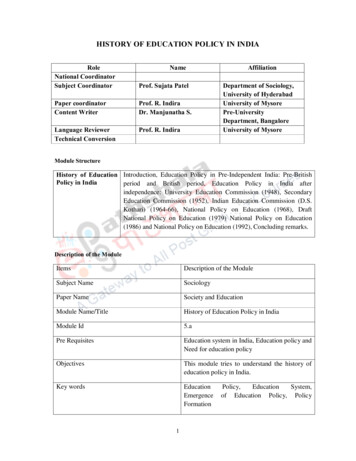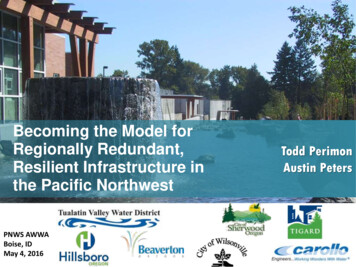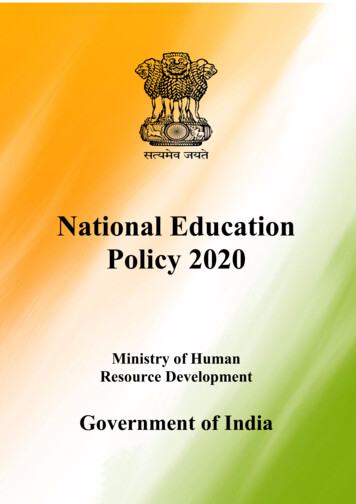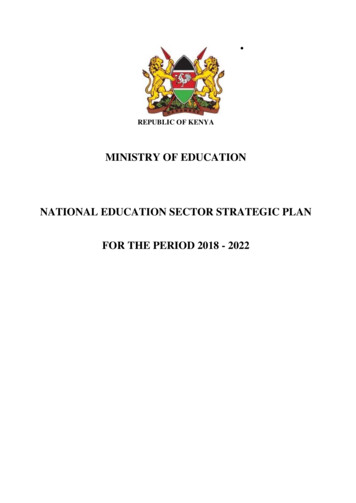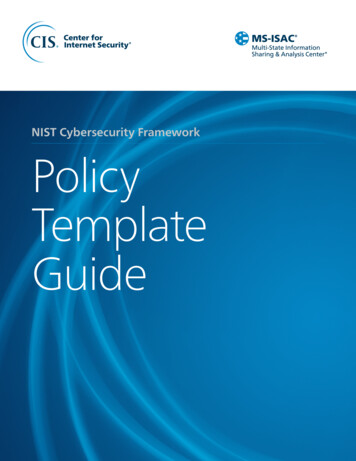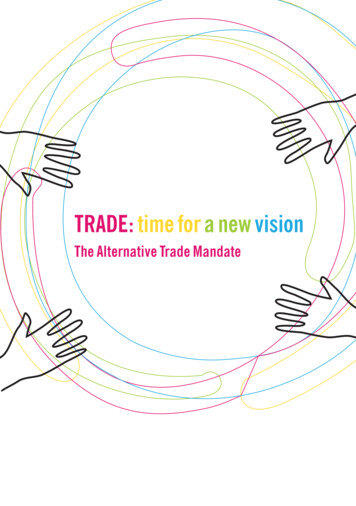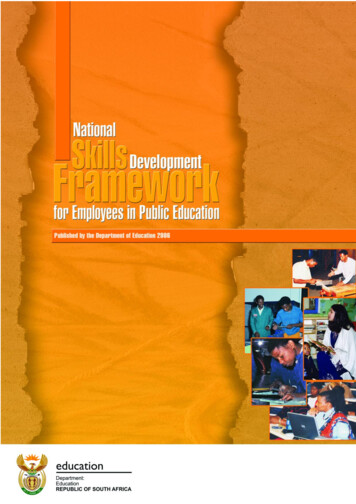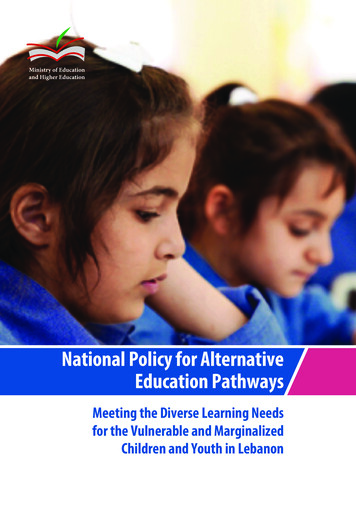
Transcription
National Policy for AlternativeEducation PathwaysMeeting the Diverse Learning Needsfor the Vulnerable and MarginalizedChildren and Youth in Lebanon
National Policy for AlternativeEducation PathwaysMeeting the Diverse LearningNeeds for the Vulnerable and MarginalizedChildren and Youth in Lebanon
2National Policy for Alternative Education Pathways
PREFACELebanon’s policy for alternative education pathways sets upprospects to meet the diverse learning needs for the marginalizedchildren and youth, through which the regularization of Non FormalEducation should be viewed as a window for change. This will provideevidence for how non-formal and lifelong learning could feed togetherinto a coherent framework for the regularization of all education.Its elaboration is aligned with the Sustainable Development Goals,Education Agenda 2030, the long-term development priorities andexisting successes driven by Lebanese Government. With a new visionof learning, reflecting national and local contextual realities, each childand youth in Lebanon, regardless of their origin, could become anagent of positive change in society.In crisis there is always an opportunity, and now could be the occasionto develop better-regulated and multi-pronged set of educationpathways that feed into the formal system. These pathways work insynergy with the formal education system. This policy is a response towhat is asked for within RACE II - alternative education pathways forthe diverse learning needs of the most vulnerable.The policy supports our efforts to address quality education for allchildren and to work towards supporting cohesion and harmony,avoiding conflict and promoting coexistence among the mostvulnerable as well as the refugees. We hope that the outcome ofthis policy will further advance the alternative pathways to learning,providing a more adaptable education, centered on equity,access, quality, accountability and transparency, with new forms ofcertification and accreditation established.Ministry of Educationand Higher EducationNational Policy for Alternative Education Pathways3
4National Policy for Alternative Education Pathways
TABLE OF CONTENTSPREFACE3ACRONYMS AND ABBREVIATIONS6GLOSSARY OF TERMS8CHAPTER ONELOCAL CONTEXT AND DYNAMICS11111415Context for Emergency ActionEducation Sector ResponseKey Current Factors and IssuesCHAPTER TWOKEY PRINCIPLES FOR ALTERNATIVE EDUCATION PATHWAYS IN LEBANONDefining learning differentlyFlexible settings and modes of deliveryTargeting the most vulnerable and marginalizedAlternative pathways to learning are egalitarian and accountableAlternative pathways to learning are flexibleCHAPTER THREETOWARDS INCLUSIVE POLICY FOR ALTERNATIVE LEARNING PATHWAYSPolicy AimPolicy ObjectivesPriority NFE ProgramsKey Indicators for NFE ProgramsPriority Policy ActionsProposed System for Direct Service ProvisionRegulatory body and functionsCONCLUSIONTowards inclusive and flexible pathways to education181819202122232626272728313437National Policy for Alternative Education Pathways5
ACRONYMS AND ESPNFENGONGFNTFOCHA6Basic Literacy and NumeracyCommunity-Based Early Childhood EducationUN Common Country AssessmentCapacity DevelopmentCentre for Educational Research and DevelopmentCommunity Learning CentreConvention on the Rights of the ChildDepartment for International Development (UK)Département d’Orientation Pédagogique et ScolaireEarly Childhood EducationEducation for AllEducation Management Information SystemEducation Sector Development FrameworkEducation Sector PlanEuropean UnionFlexible Learning StrategiesGovernment of LebanonGlobal Partnership for EducationInternational Bureau of EducationInternational Institute of Educational PlanningInternational Rescue CommitteeMinistry of Education and Higher EducationMiddle East and North Africa regionMinistry of LabourMinistry of Social AffairsMonitoring and EvaluationNational Education Strategic PlanNon-Formal EducationNon-Governmental OrganizationNational Qualifications FrameworkNational Task ForceOffice for the Coordination of Humanitarian AffairsNational Policy for Alternative Education Pathways
ODIPMURACEROVsSDGsSGBVTA3RP FUNOCHAUNRWAUSAIDWBWFPOverseas Development InstituteProgram Management UnitReaching All Children with Education in LebanonRefugee Outreach VolunteersSustainable Development GoalsSexual and gender-based violenceTechnical AssistanceRegional Refugee and Resilience Plan 2016-2017Technical and Vocational Education/ TrainingUNESCO Institute for EducationUNESCO Institute for Lifelong LearningUNESCO Institute for StatisticsUnited Nations Development Assistance FrameworkUnited Nations Development ProgramUnited Nations Educational, Scientific and Cultural OrganizationUnited Nations Population FundUnited Nations High Commissioner for RefugeesUnited Nations Children’s FundOffice for the Coordination of Humanitarian AffairsUnited Nations Relief and Works Agency for Palestine Refugees inthe Near EastUnited States Agency for International DevelopmentWorld BankWorld Food ProgramNational Policy for Alternative Education Pathways7
GLOSSARY OF TERMSActive-learning: whereby participants take active part in their learning processesrather than passively listening or adopting knowledge through rote learning.Alternative pathways to learning: alternative and multiple routes for engagingin learning, and a means of achieving educational qualifications alongside formalschooling.Capacity: ability, skill, aptitude or capability to carry something out, includingthe competence, strength, understanding and knowledge to be effective andproductive.Capacity Development: process whereby people, individually and collectively,organizationally and institutionally, strengthen their capacities to manage theiraffairs in an autonomous and efficient fashion.Child-centred: an approach whereby children are understood to be the startingpoint for breaking the cycle of poverty, discrimination and exclusion. A childcentered approach promotes change that is in the best interests of the child andis aimed at fulfilling children’s rights to sustainable human development.Communities of Practice: groups of individuals who share common concerns,knowledge and interests and who come to learn and develop together.Flexible Learning Strategies: systematic, flexible, rights-based, inclusiveinterventions designed to match needs and circumstances for excluded children(outside of the formal schooling system) to acquire functional basic literacy andnumeracy skills as well as competencies and life skills. The term is used to covervarious initiatives and different terminologies, including equivalency programs,certified non-formal education (NFE), accelerated learning programs, secondchance education, community-based education/school/learning, flexible schoolingprograms, complementary programs, alternative learning programs, etc.8National Policy for Alternative Education Pathways
Formal Education (FE): learning that takes place in education and traininginstitutions and centres. This learning is recognized by national authorities andbodies and leads to diplomas and qualifications. Formal learning is structuredaccording to educational arrangements such as curricula, qualifications andteaching-learning requirements.Governance: the processes and systems through which governments, governingbodies or civil society organizations make decisions and operate.Holistic: a complete form of education that prepares students to meet thechallenges of life in all their variety and creates meaningful connections betweenwhat they learn and their environment.Institutional capacity: the environment and climate needed for organizationsand institutions to function in terms of laws, managerial regulations, policies,culture, customs, norms, etc.Lifelong learning may be described as learning that takes place throughout life,its flexible, diverse and undertaken at different times and places. Lifelong learningis learning that takes place beyond formal schooling and throughout adult life,based on the principles of learning to know, learning to do, learning to livetogether and learning to be.Multi-stakeholder Partnerships for Education: a beneficial associationbetween partners from different spheres of society (such as the private sector,community groups) to address and tackle issues in education.Non-formal Education (NFE): learning that has been acquired in addition oralternatively to formal learning. In some cases, it is also structured according toeducational and training arrangements, but more flexible. It usually takes placein community-based settings, the workplace and through the activities of civilsociety organizations. Through a recognition, validation and accreditation process,non-formal learning can also lead to qualifications and other recognitions1.1UNESCO Institute of Statistics -education)National Policy for Alternative Education Pathways9
Systems Perspective: viewing systems as a whole, made up of many components,and considering all factors which contribute to a given issue or activity.Vocational Technical Education: Compromises two basic fields: Technicaland Vocational Education and Technical and Vocational Training. Technical andVocational training focuses on the jobs and occupations, which do not requireextensive theoretical knowledge. Technical and Vocational education relates tojobs and occupations requiring a thorough knowledge of the theory and a solidscientific and technological base and it is of 4 main levels:a. Brevet Professionnel (BP),b. BT (Baccalauréat Technique),c. TS (Technicien Supérieur),d. LT (Licence Technique).10National Policy for Alternative Education Pathways
Chapter OneLocal Context and DynamicsContext for Emergency ActionIn total 47 million people across the Arab region, live with conflict and crisis, aredisplaced and vulnerable, facing insecurity and uncertainty, with a limited sense ofbelonging and what the future holds for them. (UNESCO 2017)2 The problem ofout of school children becomes significant in countries affected by conflict, wherethe proportion increased from 63% to 87% (UNESCO 2015)3. Within this regionalcontext, the Government of Lebanon instituted The Lebanon Response CrisisPlan, which recognizes that over 1.4 million children and youth in Lebanon arecurrently identified as being vulnerable (LCRP 2017-2021)4.While better living standards and access to education may be attainable for some,the poorer and lower middle class are unable to do so and thus their living conditionsand quality of life are affected. The effect of this is stark, with lower attainment ofeducation outcomes, particularly within a family context with limited education,severely contributing to inequality of opportunity (World Bank, 2017)5.Lebanon has been further challenged by hosting of more than 1.5 million Syrianrefugees, the highest per capita ratio in the world. 35% of this population arechildren (3-18 years old) of school-going age.2345UNESCO (2017) UNESCO Strategic Framework for Education in Emergencies in the Arab Region(2018-2021) https://en.unesco.org/sites/default/files/unesco strategic framework for eie inarab region english.pdfUNESCO (2015) Education for All: 2000-2015. Achievements and Challenges. Global MonitoringReport. 5e.pdfLebanon Crisis Response Plan (2017-2020). http://www.un.org.lb/lcrp2017-2020World Bank (2017) Lebanon: Promoting Poverty Education and Shared Prosperity. SystematicCountry Diagnostic -SecM2015- l Policy for Alternative Education Pathways11
The majority of Syrian refugees have settled in low-income areas within Lebanon,spread across informal settlements already stricken by poverty and instability. Almost9 out of 10 refugees are concentrated in 251 locations, considered to be amongthe poorest and most disadvantaged in Lebanon (EU 2017)6. The public sector iscurrently under intense strain to cope with the influx of refugees. This has beencircumvented by the opening up of second shift schooling for afternoon sessions,leading to greater uptake by Syrian refugee children. With strategic and tirelessefforts taken by the Ministry of Education and Higher Education (MEHE), trendsshow moderate enrollment growth over the past years, reaching 60% of refugeesin compulsory education (age 6-15). Nevertheless, the majority of secondary agechildren of refugees remain out of school, a significant number of which cannot beoverlooked, in further exacerbating their vulnerability.The proportion of Syrian refugees living below the minimum threshold for survival(unable to afford necessities like food and shelter) has doubled in the last twoyears. Legal income-generating opportunities are limited and or restricted. This, inturn, has led to 97% of the refugees employing negative coping strategies suchas reducing the amount spent on food, dropping out of school, child labour, earlymarriage for girls, as well as the potential for young people falling into radicalizationand extremism. (VASyR 2016)7.But tensions are not just economic. There has been an upsurge in cultural andpolitical tensions, especially in the under-served localities settled by refugees,notably in the North where 30% of Syrians live and in the Bekaa, where 34% areconcentrated. Within this contextual reality, Lebanon’s response on many fronts,particularly the education front, has been vital to ensure that a whole generation ofyoung refugees and vulnerable Lebanese’s do not get left behind.6712European Commission (2017). Lebanon: Syria Crisis sheets/lebanon syrian crisis en.pdfUnited Nations Children’s Fund (UNICEF), United Nations High Commissioner for Refugees(UNHCR) and the United Nations World Food Program (WFP) (2016). Vulnerability Assessment forSyrian Refugees in Lebanon (VASyR-2016) https://reliefweb.int/sites/ l Policy for Alternative Education Pathways
MOST VULNERABLELOCALITIES IN LEBANONMost VulnerableCadastres host87% Displacedfrom Syria& 67% DeprivedLebaneseAkkarNorthBaalbek/Hermel!Mount LebanonBeirutBekaaHigh Pressure(37 Cadastres)Substantial Pressure(77 Cadastres)El NabatiehMost Vulnerable2nd Most Vulnerable3rd Most VulnerableSouth4th Most Vulnerable5th Most VulnerableSource: LCRP 2017 update – the map and figures are currently under review to include more vulnerablecadasters - it will be updated later in 2019.National Policy for Alternative Education Pathways13
Education Sector ResponseConsidering the enormity of the task in accommodating vulnerable Lebanese andan influx of refugees, the Lebanese Ministry of Education and Higher Education(MEHE) with the support of donor agencies and education partners, has copedremarkably well in the development and implementation of the first phase of‘Reaching all Children with Education’ (RACE I) (MEHE 2014-2016)8 as a crisisresponse plan. Centered around the three pillars of access, quality and systemsstrengthening, and within the framework of the ‘No Lost Generation’ (UNICEF2013)9, MEHE constructively utilized education and schooling as a primary shield forchild protection, limiting disruption where possible, helping children retain somenotion of routine and familiarity, while providing them with learning opportunitiesto carry on with their lives. RACE I demonstrated commitment and good progresstowards increasing the demand for education and thus encouraging enrollment ofboth vulnerable Lebanese and Syrian refugees into formal public education.The first phase of RACE I (MEHE 2014 to 2016)10, has been completed with muchsuccess. Building upon the achievements and addressing the systemic issues thatthe program had faced, RACE II: 2017 to 2021, (MEHE 2016)11 has been launchedwith the goal of sustaining increased and equitable access to quality educationfor all children aged 3 to 18 in Lebanon. RACE II is framed within the SDG goal 4/education, aimed to ‘’ensure inclusive and equitable quality education and promotelifelong learning opportunities for all.’’(UN 2015-2030)12 Within this context theMEHE as a priority through RACE II acknowledges the importance of addressing theneeds of the child, family and community, whether they be vulnerable Lebanese orrefugees.8910111214MEHE (2013). Reaching all Children with Education in Lebanon b2015/Projects/RACEfinalEnglish2.pdfUNICEF (2013) No Lost Generation. Protecting the Futures of Children Affected by the Crisis in Syria.https://www.unicef.org/appeals/files/No Lost Generation Strategic OverviewJanuary 2014.pdfMEHE (2014) Reaching All Children with Education (RACE I: 2014-2016). Ministry of Education andHigher Education. rojects/RACEfinalEnglish2.pdfMEHE (2016) Reaching All Children with Education (RACE II: 2017-2021). Ministry of Educationand Higher Education. 20II FINAL%20Narrative 29AUG2016.pdfUnited Nations (2015) Sustainable Development Goal in Education. National Policy for Alternative Education Pathways
Key Current Factors and IssuesLebanon clearly sees education as a fundamental human right and a life-savingintervention, and its schools-based response to the refugee crisis should beacknowledged. Despite the evident successes of RACE I, the increase in the numbersof refugees, leaves a significant number of Syrian children without access to formaleducation. While the MEHE is making constructive progress in cooperation witheducation partners towards redressing this, the problems seem to relate to whetherchildren and youth are able to get to school, or parental restrictions due to povertyand livelihood circumstances or a lack of commitment to education. Systemically,the limited available funds to scale up access on the one hand, and quality on theother, are further issues that restrict progress.Prior to the Syrian crisis, Lebanon’s public sector education was involved in aprocess of reform, notably to address low academic attainment in its schools, andincrease the spread of pre-schools for vulnerable Lebanese communities. Successeswere achieved in assuring access to education, and it goes without saying that theSyrian crisis and the priorities of the emergency response, have redirected effortselsewhere, but the need for reform remains solid.This policy is a response to what is askedfor with RACE II - alternative educationpathways, which provide an opportunityfor Lebanon to address education for allbut also to work towards supportingcohesion and harmony, avoidingconflict and promoting coexistenceamong the most vulnerable as well aswith the refugees. The importance forrecognizing and accepting differenceas a valuable common good, enricheslives.More than1/2displacedSyria ChildrenoffromareSource: LCRP 2017 updateNational Policy for Alternative Education Pathways15
UNESCO 2018The public sector employs only 43.8 per cent of the 88,413 teachers (RACE 2015)13 inLebanon and numbers are stretched. Teacher qualification comes after a 3-4 yearsuniversity degree. The national pupil teacher ratio in basic education is 7.4 but thisvaries from region to region. In order to deal with the effects of the refugee crisis, theMEHE is employing contractual teachers to supplement its own staff.There is also a large contingent of Lebanese educators and facilitators in nonformal settings. A fair proportion of these people, both contractual teachers andNFE facilitators, have not been trained in managing large groups or been helpedprofessionally in how to engage in child-centered practices - or how to providesupport in areas such as health, well-being and trauma alongside the programcontent.School directors and teachers must frequently work independently to find practicalsolutions to quickly changing situations. At the forefront teachers in the publicschool sector have been facing mounting demands on their time and resources.Newly hired teachers were particularly challenged to address the individual needsof traumatized refugees within large classrooms in addition to challenges related tothe differences in their skills and age. Some teachers have had to resort to teaching1316MEHE (2015) Reaching All Children with Education in eb2015/Projects/RACEfinalEnglish2.pdfNational Policy for Alternative Education Pathways
solely in Arabic while others have noted that the whole dynamic of classroomshas changed, and requested improved basic learning material to replenish schoollibraries and enrich the learning environment.Vulnerability assessments identify obstacles for low enrollment of Syrian refugeechildren (VASyR 2016) as follow14: Some public schools have no access to piped water and sanitation facilities,significant in under-serviced areas where the pupil to latrine ratio may be veryhigh (UNHCR 2017). School Infrastructure which in some cases not well equipped with adequatelatrines and wash facilities. Access to schools which may be geographically too far from refugee settlementsand neighborhoods. Trauma resulting from conflict, migration, displacement and transition. Parents unable to commit to a year’s education as refugee families are oftenliving with uncertainty about moving on, and identifying opportunities to settledown. Bullying and violence is experienced by both Syrian and Lebanese pupils andparents.14United Nations Children’s Fund (UNICEF), United Nations High Commissioner for Refugees(UNHCR) and the United Nations World Food Program (WFP) (2016). Vulnerability Assessment forSyrian Refugees in Lebanon (VASyR 2016) sources/VASyR2016.pdfNational Policy for Alternative Education Pathways17
18National Policy for Alternative Education Pathways
Chapter TwoKey Principles for Alternative EducationPathways in LebanonDefining learning differentlyPeople are always learning, at all time, wherever they are, whoever they are.We learn from experience and from exchange with others. We interact, wediscover, inquire, observe, copy and mimic, practice and fail, try again and teachothers. Each new day brings the need for new skills and understanding. Schoolsand formal education settings dominate the education agenda worldwide andoften are the only channel to get competences tested and certificated. Theinadequacies of students sitting in rows in teacher-led classrooms for definedperiod of times - focusing on one subject area without any application to the realworld - are something all education systems are having to face up to. A movetowards a more versatile and diverse education systems to accommodatethe multiple locations and pathways for learning, provides an opportunityfor education systems to diversify and work towards enhancing the quality ofeducation provided. Alternative pathways (MEHE 2016)15 to learning are a firmrecognition that learning isn’t just formal and that there are a multitude ofapproaches within different learning spaces. Alternative pathways are any learningactivities which occur both inside and outside of formal education. In other words,education where learning can be improvised and adapted to any specific tasksand any population groups, its aspirations and needs. Protection will be at theheart of NFE at all levels, with emphasis on non-violent policies.In the case of Lebanon, such a form of education would be to provide vulnerablechildren and young people and refugees with immediate tools, necessary know-15MEHE (2016) Reaching All Children with Education: RACE II 16/Oct/RACE%20II FINAL%20Narrative 29AUG2016.pdfNational Policy for Alternative Education Pathways19
how and attitudes, that are not always possible for them through the formal system.The aim is to provide disadvantaged groups to access or return to school or for thosegroups whose education pathways were interrupted because of poverty, conflict orviolence so they can eventually catch up with the Lebanese educational system.Flexible settings and modes of deliveryAlternative pathways make full use of the skills, knowledge and competenceswe use in life or will use in life rather than narrowly interpreted school-basedcompetencies. They can take the shape of anything from community meetings,workshop sessions, workplace training, entrepreneurship programs, languageclasses, arts and crafts groups, multimedia clubs, youth skills counselling, self-helptherapy, after- school classes, awareness groups or peer learning.The MEHE has already made good progress towards developing andimplementing Preparatory Early Childhood Education, Community Based EarlyChildhood Education (CBECE), Basic Literacy and Numeracy (BLN), AcceleratedLearning Program (ALP), Youth BLN and Technical and Vocational Training. Thecontent of these learning programs is further being planned and developedby the Center for Educational Research and Development (CERD) in closecoordination and cooperation with the Program Management Unit (PMU) at theMEHE. These are all good examples of highly adaptable learning pathways, allcertified and working towards the formal education system. They can suit anynumber of settings and delivery modes. Some of these programs can also takeplace within formal schools, others in community learning centres or spaces,as part of mobile teaching schemes, at weekends or in the evening. They canmould to different teaching methodologies (multi- grade, activity-based learning,specific approaches for people with a disability or special needs children.Alternative pathways to learning in Lebanon could also encompass everythingfrom remedial language support designed to support retention, vocational andlivelihood skills development, to accredited programs supported by the MEHE.The establishment of safe, protective, and quality learning environments is central,to ensure learners’ best interest as well as to protect children and youth based onthe “Do No Harm” principle. Utilizing the settings that approved NGOs provide,allows opportunities to work with children on issues that cause tension, exclusion,conflict, violence and lead to extremism. The NGOs settings also allow facilitators to20National Policy for Alternative Education Pathways
respond constructively to the culturaldiversity, forming the basis for cohesionand harmony, conflict avoidance, nonviolence, and peaceful coexistence. Allof this is certainly possible and could bevery easily incorporated as part of thecurrent RACE II programs ranging fromAccelerated Learning Programs (ALP),Basic Literacy and Numeracy (BLN),Early Childhood Education (ECE), andagricultural techniques. Jean Hatem - UNESCO 2018Targeting the most vulnerableand marginalizedThe focus of alternative learningpathways should be the needs ofdisadvantaged and vulnerable groups,thanks to accessible and flexible,learner-centered channels to educationwith methodologies close to learners’needs and contextual realities, namely: Vulnerable out of school childrenand youth, such as: children andyouth with special needs, statelesschildren, working children, etc Refugee children and youths:Syrian, Palestinian outside campsand Iraqi children Hard-to-reach population groups(particularly children fromInformal tented settlements) Girls, particularly those at riskof early marriage and sexualexploitation Ethnic minority children andyouthsNational Policy for Alternative Education Pathways21
UNESCO 2018Alternative pathways to learning are egalitarian and accountableThe purpose of alternative learning pathways is to ensure that everyone, whatevertheir background, is given the opportunity and skills to reach their full educationpotential. Enables learners to acquire essential academic competences and contributesto their personal development, thereby preparing them to step confidentiallyto the formal education system. Learning content and educational tools of all kinds can be produced reflectinglived contexts and are specific to identified local needs. Education content is prepared directly relevant to the specific needs oflearners, based on the Lebanese curriculum, empowering them to catch upwith their peers in the formal system. Education skills are prepared directly relevant to work and life-long activities,seeking to meet basic everyday needs (such as water, good, shelter, health,income). Promoting cohesion and harmony and conflict avoidance, non-violence,and peaceful coexistence do not require lengthy investment over time andcan prepare learners immediately reflecting the environment and context ofindividuals lives. Require no certification or formal testing to enter into. They do not discriminateagainst those who are not able to afford formal schooling or have no specificprior knowledge needed for schooling.22National Policy for Alternative Education Pathways
Are less likely to create social distinctions or intimidate learners. Relations between educators and learners are less formal. They are a step awayfrom authoritarian teaching. Some programs may not necessarily compartmentalize learners by age, ability,gender, etc. Benefit the most excluded, allowing the disadvantaged to catch up with theadvantaged. Includes qualified and well-trained educators preferably form the community.Alternative pathways to learning are flexibleDepending on the nature and objectives of each program: They are programs that provide basic levels of education but are also aboutpromoting human-centered development an
Technical and Vocational Education/ Training UNESCO Institute for Education UNESCO Institute for Lifelong Learning UNESCO Institute for Statistics United Nations Development Assistance Framework . pdf/97498-CAS-P151430-SecM2015-0202-IFC-SecM2015- 0073-MIGA-SecM2015-0047-Box391476B-OUO-9.pdf.

